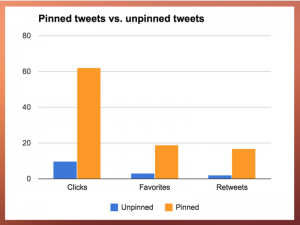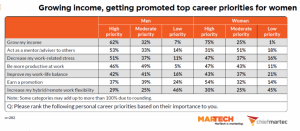— December 5, 2017
Pricing strategies don’t just come down to what you charge, it can come down to how you present your prices.

You’re trying to win the client who tops all clients; you’ve been burning the midnight oil obsessing over every last detail:
- What is going to impress them?
- How can we make ourselves stand out from the crowd trying to win them over?
- I hope we come across as reliable and talented (so trust is already established).
You nearly have it finished. It does an excellent job of highlighting your skills, USPs and exactly how you’re going to turn their life around. No small feat, right?
And it’s not over yet; now comes the biggest hurdle…pricing up your offering. Sigh. Yep, this is undoubtedly the trickiest bit, a hot-mess of numbers, procrastination and headaches.
We can help you leap over the pricing hurdle with 5 effective pricing strategies that will make it stress-free and easy. And best of all? It will prevent the finalization of your proposal being a long, drawn-out deliberation.
Let’s dive in!
1. Pricing Strategies: Hook ‘Em with a Gripping Title
First thing’s first; putting effort into a title doesn’t begin and end with the front page – each section of your proposal should have an enticing title, and that includes the pricing page.
You want your client to be engaged all the way through your proposal, particularly at the pricing pages because it can be the make or break of the win.
Your pricing section title might look a lot like this:
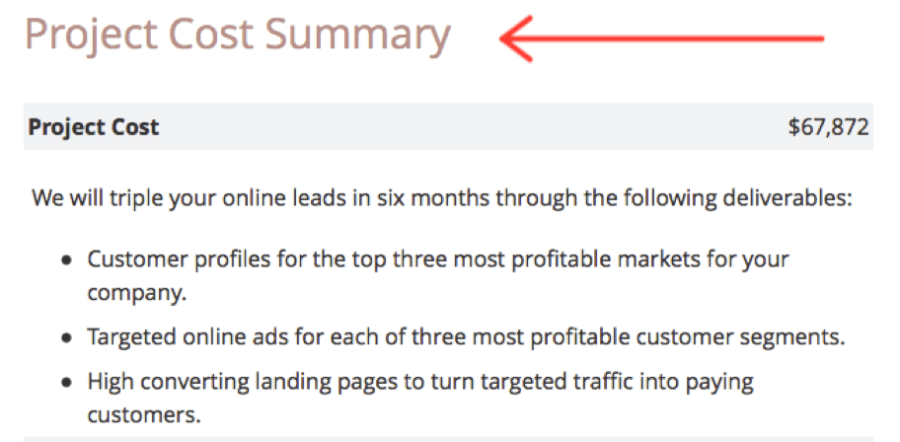
Ok, this is to the point for sure, but let’s face it; it’s not moving you closer to a sale.
This is the type of title that no one really reads, they skim over it and just absorb that this is the ‘money bit’.
We don’t want them to be thinking that. So what’s the best way?
The trick here is to remind them of the wealth of benefits they’re going to get by choosing your company. Let’s consider how it could be written for maximum impact:
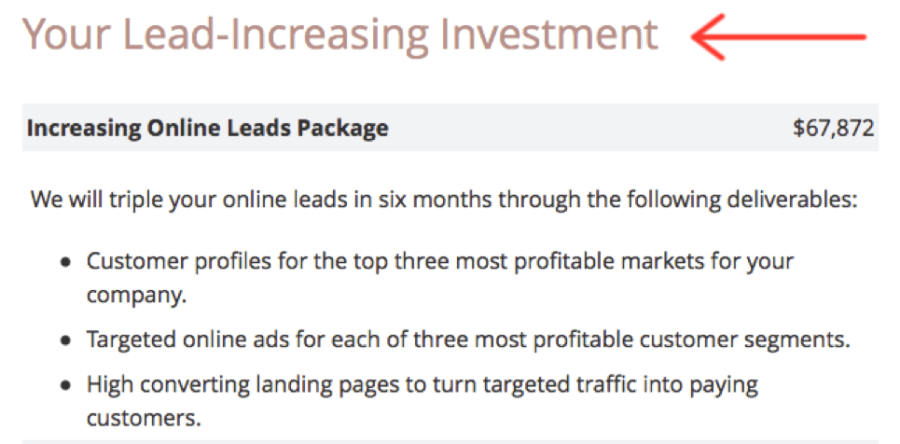
See what we did there? You’re taking the client back to the reason they’ve contacted you and reminding them that this is an investment, they’re getting something great for their money that’s going to help their company progress.
This takes the spotlight off the dollar signs and onto the end delights they’re going to get.
Also, only use terms that the client is going to understand and is relatable to them. Don’t jump in with industry jargon or try to be overly clever, because this won’t work. They’ll tune out.
Keep it short and simple, highlighting the clear benefits to them – it’s a winner, I promise!
2. Pricing Strategies: The Power of the Bundle
The bundle technique is a surefire pricing strategy to limit price objections, due to the simple reason that viewing your options in an itemized list is daunting.
The more numbers there are the harder it is for our brain to process them, so it makes complete sense to present them to your client in one, clear figure that makes sense to them.
First, let’s look at what to steer clear of when pricing up your offering:
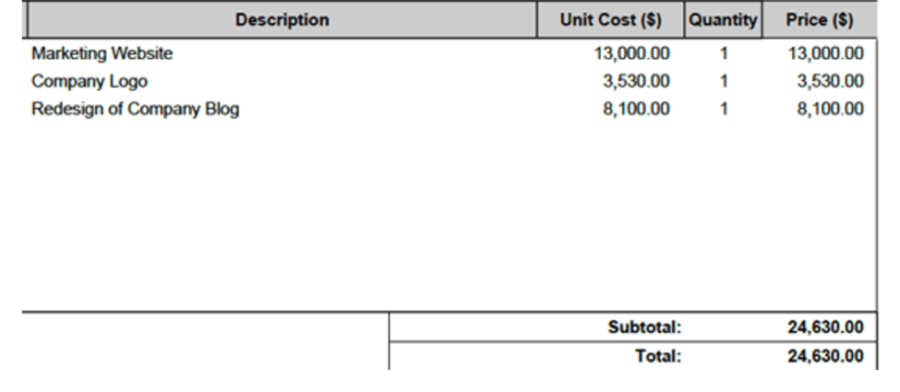
So what’s wrong with that? You ask. Well, firstly you’re not telling your client what you can do for them, you’re not selling your services.
It’s just a load of numbers thrown at them, which will guarantee to make them recoil and start searching for cheaper options.
You’re inviting the client to pick apart your costings; it’s hard for them to think about anything else.
The second big problem here is a little psychological issue called Loss Aversion. The theory is that the psychological power of loss is double that of any gain, which means that people are more willing to take risks to avoid a loss.
What does that mean for our cost estimate?
It means that your client reading the itemized list will experience a perceived loss at every line with a price next to the service. It evokes a desire to avoid as it’s potentially psychologically painful, which is definitely not the feeling you want your clients to be experiencing.
The Pricing Bundle
Following the Loss Aversion theory, the pricing bundle is your best friend. It’s going to communicate your value, your expertise and exactly what you bring to the table; with one bundled up cost.
Let’s take a look at one in action, from our marketing proposal template:
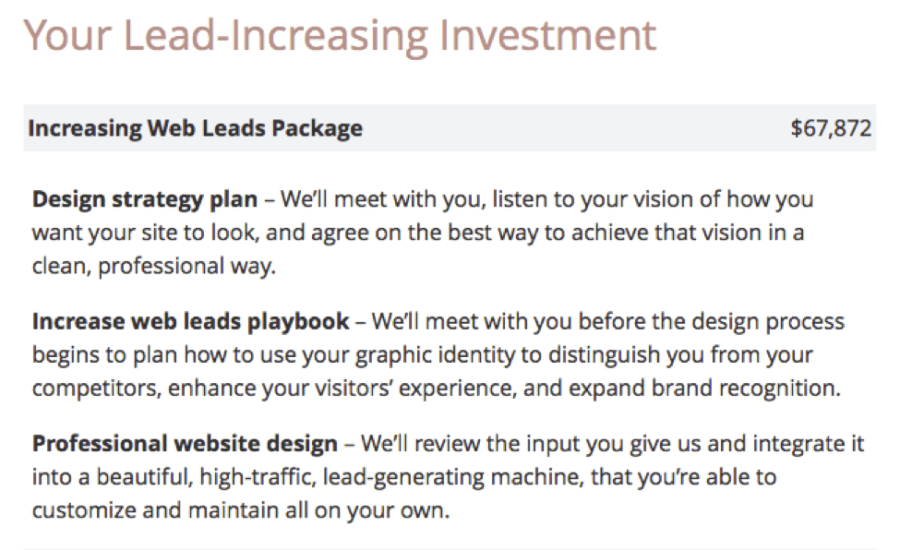
- We’ve got a gripping, benefit-reminding title.
- There’s a clear price at the top so they don’t skim across the services to reach it at the bottom.
- All of the services are about your added-value, telling them in no uncertain terms what handing over their precious money will give them. It hits home that it’s an investment, not parting with money with no return.
Because at Docsketch, we help thousands of companies speed up their proposals and sales documents, we have access to some great sales data.
In our internal research of 25,000 proposals and contracts, we found that this bundling technique wins a whopping 36% more contracts/jobs than traditional line item pricing.
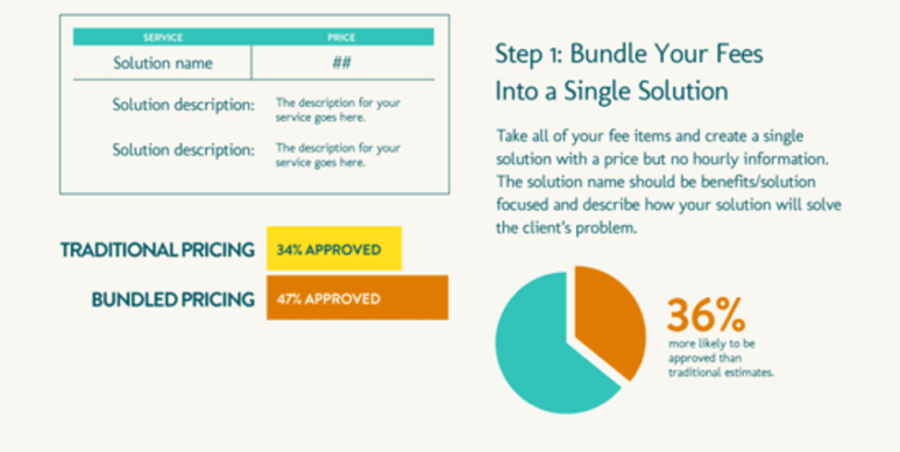
Seems like a no-brainer, right?
3. Pricing Strategies: Offer Multiple Options
This is super important, because if you only offer one option you’re ultimately presenting your proposal to require a ‘yes/no’ answer.
Offering your client three options rather than one is going to change their thinking from:
“Should I hire this company at that price?”
To a far more productive way of thinking:
“Which of these options are going to give me what I need for the right price?”
In our research of 25,000 proposals and estimates, we also investigated how options affected the outcome. The results showed that an overwhelming 32% more revenue was won with one or two additional options presented to the client.
That’s pretty impressive.
And here’s something extra to take note of: most people will choose the middle option.
Psychology tells us that people are more likely to go for the value in the middle, just because they automatically resent the high price and don’t want to be cheap by going for the low price.
So following this rule, make sure you put the option you want your client to choose in the middle…and the odds are, if you’re strategic about – they will!
There are some specific guidelines that will make sure you hit the nail on the head every time.
- Offer up options that are basic, enhanced and premium That way you are offering a broad range, with clearly defined stages.
- Make sure the price difference is actually a difference. There needs to be significance in it, or it’ll be even more confusing for them. Spell it out clearly and be bold.
- Give options a name, price and description. You need to be clearly communicating exactly what the client will get from each option; but focus on business results, not overly-technical descriptions that’ll make them scratch their heads.
Let’s look at an example of a persuasive set of options for a marketing agency:
Option 1: Brand exploration to cement brand identity £5,000
A five-day strategy session where we delve into the essence of your brand and surface with a powerful, strong and unique identity. We will create your Branding Guidelines for you to base all your marketing communications on moving forward.
Option 2: Brand exploration, a content marketing plan and website copy revamp £7,000
Everything that you get with Option 1, plus an overhaul of your current website copy to showcase your new brand online. We will also create a marketing plan to drive an additional 10,000 visitors to your website in a month.
Option 3: Brand exploration, a website revamp, a content marketing plan and 6 months of social media £12,000
Everything from Options 1 & 2, plus 6 months of ongoing social media promotion which will propel your newly developed brand into the online world. We expect to see 60% more online engagement in the first 6 months.
The likelihood here is your client will go for Option 2; diving straight into a 6-month social media commitment when their brand needs work just isn’t going to happen.
The main goal here is to entice the client to pick the option that works for you; which will be the middle-priced option. If they go for the expensive option – great! But that shouldn’t be your goal.
By giving choices you’re making the client feel in control of the process; they have a say that isn’t just ‘yes/no’. It’s not backing them into a corner by opening a bigger conversation where they feel more inclined to feel good about their decision.
Let’s be honest, most of your clients are bosses and bosses like to make decisions. They like to be in control. Giving them a choice will make them happy, which is a big win for you.
4. Pricing Strategies: Give Discounts, The Right Way
So many people get discounting wrong; they dive in trying to retain clients but it comes across as desperate and frantic, rather than calm and giving.
You need to seem appreciative rather than ‘I’m going to chop a big lump off the price so you still like me.’
Your discount should reflect that you’re reducing the price because you value the potential partnership. You want to give the perception of a professional compromise.
Where do you start? Well, there are two main aspects of discounts that you need to take into consideration:
Context: because you’re worth it
You need to make sure you’re sending the right signal about what you’re worth and the type of behavior you’re encouraging.
Think of it this way – if you offer a big discount to a new client, you’re basically saying your offering isn’t worth that much. You’re also setting a precedent for future business with them.
You can’t reel them in with low prices, then suddenly flick the switch in the future with highly raised prices. Once it’s established, your pricing will be hard to change with a particular client.
A more effective way is to offer a discount if everything’s paid upfront – that way you look organised and you manage to avoid the risk of failure to pay later down the line.
It’s all in the presentation
How you present the discount is the most important thing to consider. Take a look at these examples:
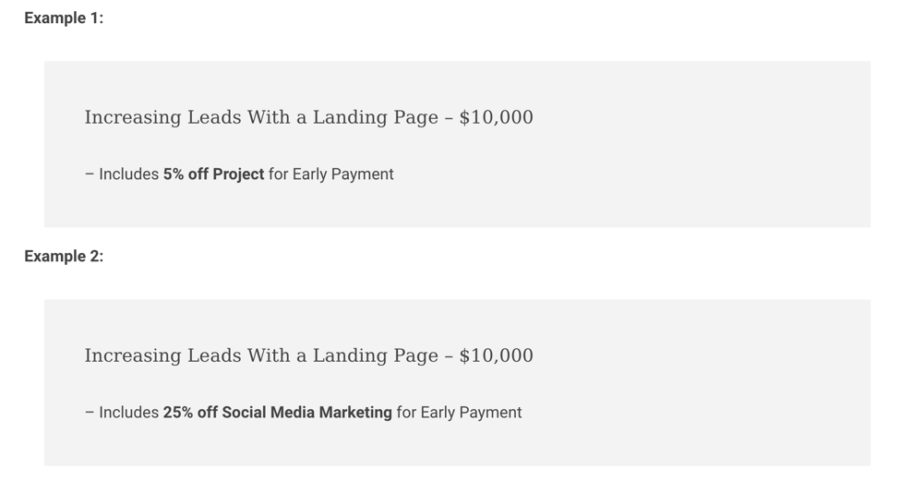
So say the discount for both of these options is $ 500, Example 2 is going to put a fire under them because it’s a bigger percentage. It’s very simple. It looks like the better deal and you get the added bonus of enticing them for an add-on service of social media.
But the real magic happens when you combine these tactics together to make an all-singing, all-dancing discount offer.
Follow these rules, recite them and memorize them; you’ll never look back.
5. Pricing Strategies: Small Words, Big Impact
Words are powerful. They can ignite emotions, evoke action and change perception. The way you write can be hypnotic, we’ve seen classic writers like Agatha Christie and Mark Twain use hypnotic writing techniques to grip readers. It’s an age-old strategy.
You can use hypnotic writing on your pricing pages to convince and persuade. It works, I promise.
The gist is to use minimal words, but make them powerful and evocative.
Joe Vitale, God of hypnotic writing and author of Hypnotic Writing: How to Convince and Persuade Your Customers with Only Your Words, advises to use words like YOUR, YOU, YES, FREE, LOVE, NEW, DISCOVERY, EASY, SIMPLE, EFFORTLESS, ALERT, ANNOUNCING, BREAKTHROUGH.
These will make your customers sit up and take notice. Words can make people trust you, they are a powerful sales tool that is at your (or your rep’s) disposal, not to pointlessly fill the page.
Look at this example:
Seamless Software Subscription – £200pcm
Your discovery of how xx software will transform your company’s productivity starts here. The installation is effortless, free and simple with an affordable monthly subscription with easy access to ongoing support. You only have to say yes!
See how many hypnotic words I’ve throw in there? It’s so much more interesting than how it could be written with no effort:
Monthly Software Subscription – £200pcm
We offer free installation and a monthly subscription that gives you ongoing access to our support team.
YAWN! There’s zero reason to use boring language on your sales proposal pricing.
It’s your chance to take the focus off the money and onto your brand personality. Form a connection, don’t send them to sleep.
There you have it; 5 easy ways to turn your pricing into a powerful, converting machine. Remember it’s your last chance to pitch, it’s the one thing standing between you and your client, let it shine and you’ll soon start to see those proposals turning into real life, talking, paying clients.
Which, when all is said and done, is our main goal, right?
No more head scratching and happy pricing!
Do you have any more pricing strategies to throw into the mix? Let us know below.
Business & Finance Articles on Business 2 Community
(123)
Report Post


